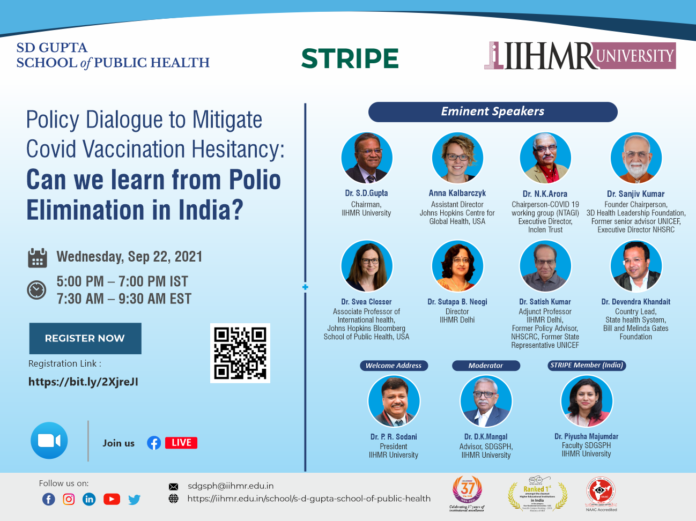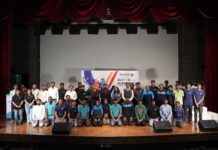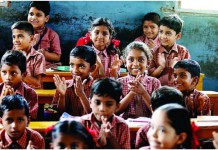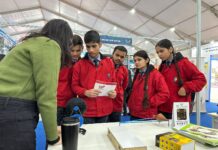What can be learned from Polio Elimination in India: IIHMR UNI.
Jaipur, 23.09.2021: IIHMR University, under the aegis of SD Gupta School of Public Health, organized a Policy Dialogue to Mitigate COVID Vaccination Hesitancy. The dialogue aimed to identify the stimulants for removing COVID-19 vaccine hesitancy amongst people, understand primary reasons for vaccine hesitancy and address the hesitancy building on lessons learned from the Polio vaccine elimination program in India.

Important Announcement – EasyShiksha has now started Online Internship Program “Ab India Sikhega Ghar Se”
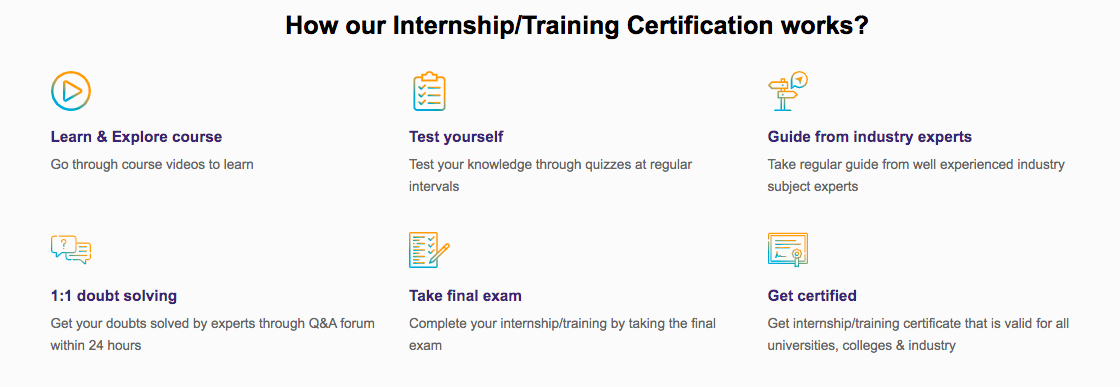
Dr. PR Sodani, President, IIHMR University, delivering the welcome address, said, “Vaccine hesitancy is an issue we face today due to economic, financial, social, or even policy reasons. In-depth research is needed at the community level to understand vaccine hesitancy, which must be investigated. The polio eradication program has given several learnings for public health professionals which can be adopted to address the covid vaccine hesitancy. He said that the deliberations of the policy dialogue will clarify Vaccine Hesitancy and Vaccination Hesitancy.”
Dr. D.K. Mangal, Advisor, SD Gupta School of Public Health, IIHMR University, moderated the Policy dialogue. Dr. Piyusha Majumdar, Faculty SDGSPH, IIHMR University, represented Synthesis and Translation of Research and Innovations in Polio Eradication (STRIPE) as a member in India.
Dr. S.D. Gupta, Chairman, IIHMR University, said, that “Vaccine Hesitancy is a refusal of vaccine or delay in acceptance vaccine despite the availability of vaccine services. It is majorly context-specific influenced by several factors like misinformation, conspiracy theory of anti-vaxxer, trust deficit group, vulnerable/hard to reach groups showing indifference towards the vaccine. The vaccine hesitancy issue could be effectively managed by addressing 4 As -increasing the affordability, accessibility, awareness regarding the vaccine, remove vaccine apprehensions; 3 Bs- understand the belief system, working on the structural barriers of vaccination, and change the behaviour of hesitant and 3 Cs – activities to increase vaccine confidence, innovations to remove complacency and make the vaccination process convenient and above all generating trust towards the government and health system. A robust monitoring framework led interpersonal communications could be instrumental in fastening the COVID vaccination in India.”
Empower your team. Lead the industry
Get a subscription to a library of online courses and digital learning tools for your organization with EasyShiksha
Request NowDescribing the Synthesis and Translation of Research and Innovations in Polio Eradication (STRIPE) Project, Dr. Anna Karlbarcyzk, Assistant Director, Johns Hopkins Centre for Global Health, USA, said, “The Synthesis and Translation of Research and Innovations from Polio Eradication (STRIPE) is a multi-phase project which aims to map, package, and disseminate knowledge from polio eradication initiatives, using an implementation science lens. STRIPE collaborates with Johns Hopkins University and seven international consortium partners in Afghanistan, Bangladesh, DRC, Ethiopia, India, Indonesia, and Nigeria. Lessons have been translated and disseminated broadly via publications, dialogues, a Massive Open Online Course, and educational materials. STRIPE highlights how these lessons can be used to tackle pressing and emerging global problems, including COVID.”
Dr. N.K. Arora, Chairperson NTAGI (covid 19 working group), Executive Director, Inclen Trust International, India, said, “The adult immunization has taken up in a massive state for the first time and people were not sure how will it go. It was a big challenge to vaccinate such a large population. The only platform which could address this was an IT platform. To ensure a smooth process, we switched to IT Platforms like EVIN- Electronic Vaccine inventory Network, which was built to manage vaccine supplies in different stores to maintain the supply system and the other IT portal CoWIN which made the sole mechanism by which Indians can obtain vaccines against Covid-19. The CoWIN platform can monitor vaccine supply to the last vaccination centre. The stockouts is not common. During the last two years, almost 2000+ crores have been invested in vaccine research that resulted in reliable vaccines. Currently, India is up with two vaccines, but we will have an option of 7-8 vaccines to choose from in the coming time. Now more than 62 crores of people are vaccinated, and we have complete details about them. A proactive social mobilization strategy for rebuking the rumours is undertaken proactively.”
Dr. Sanjiv Kumar, Founder Chairperson, 3D Health Leadership Foundation, Former senior advisor UNICEF, and former Executive Director NHSRC, said, “People’s hesitation in taking a vaccine is not new. It was addressed during routine immunization of children and women to achieve universal child immunization in 1990 and achieve polio elimination. The factors contributing to vaccine hesitancy vary from community to community hence need to be addressed locally with community leader’s engagement.”
Dr. Svea Closser, Associate Professor of International Health, Johns Hopkins Bloomberg School of Public Health, USA, said, “The Indian polio program’s “107 Block Plan” was an innovative program that overcame vaccine hesitancy in Uttar Pradesh and Bihar. Vaccine hesitancy in those areas was largely driven by the mismatch between frequent, well-funded polio campaigns and under-resourced health systems. The polio program broadened its scope to include various activities, from filling vacant medical officer positions to constructing latrines. Its communications strategy included information on routine immunization, oral rehydration solution, breastfeeding, and handwashing. This broader approach was key in eliminating polio from India.”
Dr. Satish Kumar, Adjunct Professor, IIHMR Delhi, former Policy Advisor, NHSRC, Former State Representative UNICEF, said, “COVID 19 pandemic continues to spread. Lessons learned from Polio Eradication campaigns in India in adopting communication for development as core program implementation strategy, government ownership, technical advances in choice of vaccines, social mobilization, private partnership, and innovations in program delivery will be beneficial. Systemic issues like income, education, food and social security surrounding COVID vaccination and vaccine hesitancy must be addressed, and efforts to build an inclusive and sustainable society be pursued to mitigate the future threat of COVID like pandemics and its consequences.”
Dr. Mangal, Advisor, SDGSPH, IIHMR University, who moderated the event, said, that “More than 6 billion COVID vaccines have been administered across 184 countries in the world. Until 21st Sept 2021, around 812 billion COVID vaccines have already been administered in India. The major threat to the impact of the COVID-19 vaccine in preventing disease and death is its lower uptake of Vaccines due to hesitancy. According to WHO, vaccine hesitancy is a delay in accepting or refusing the safe vaccine despite available vaccines. Vaccine hesitancy is caused due to complex and contesting factors that can vary across time, place and is also influenced by complacency and confidence. Vaccine hesitancy can be due to conspiracies and misleading information on social media.”
Dr. Sutapa Bandyopadhyay Neogi,MD, MBBS, Director, IIHMR Delhi, said that personal views and fears to logistical problems getting to vaccine sites, lack of trust, and lack of family support with being negligible awareness about the same are a few reasons for the vaccine hesitancy. While the community has lost faith in the health system, that is primarily due to the government’s inability to meet the expectations of the ordinary people, especially during the 2nd wave of the COVID pandemic. Also, a lack of awareness of the process of vaccination and its registration made the situation worse. Women, primarily pregnant women, were scared to get vaccinated because of insufficient knowledge of its effects on their health and their child’s health. Vaccine hesitancy mainly occurred due to the unavailability of the correct answers from reliable sources.
For more Information visit Easyshiksha and Hawkscode
ALSO READ: world-food-day
Get Course: Learn-to-Code-with-Ruby































